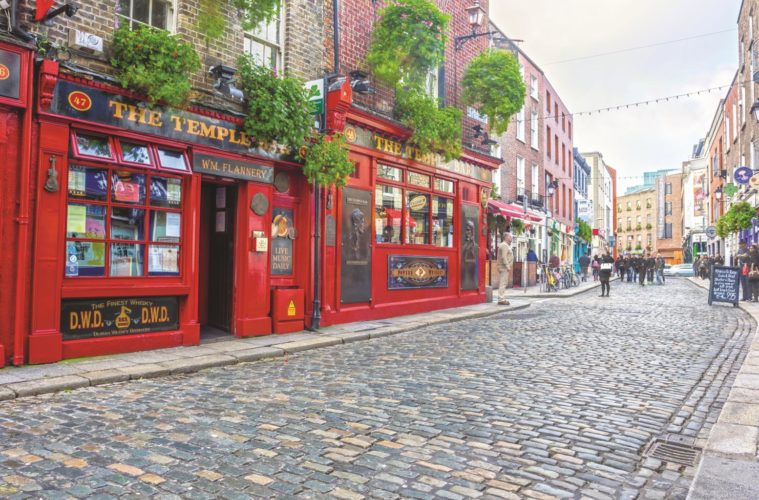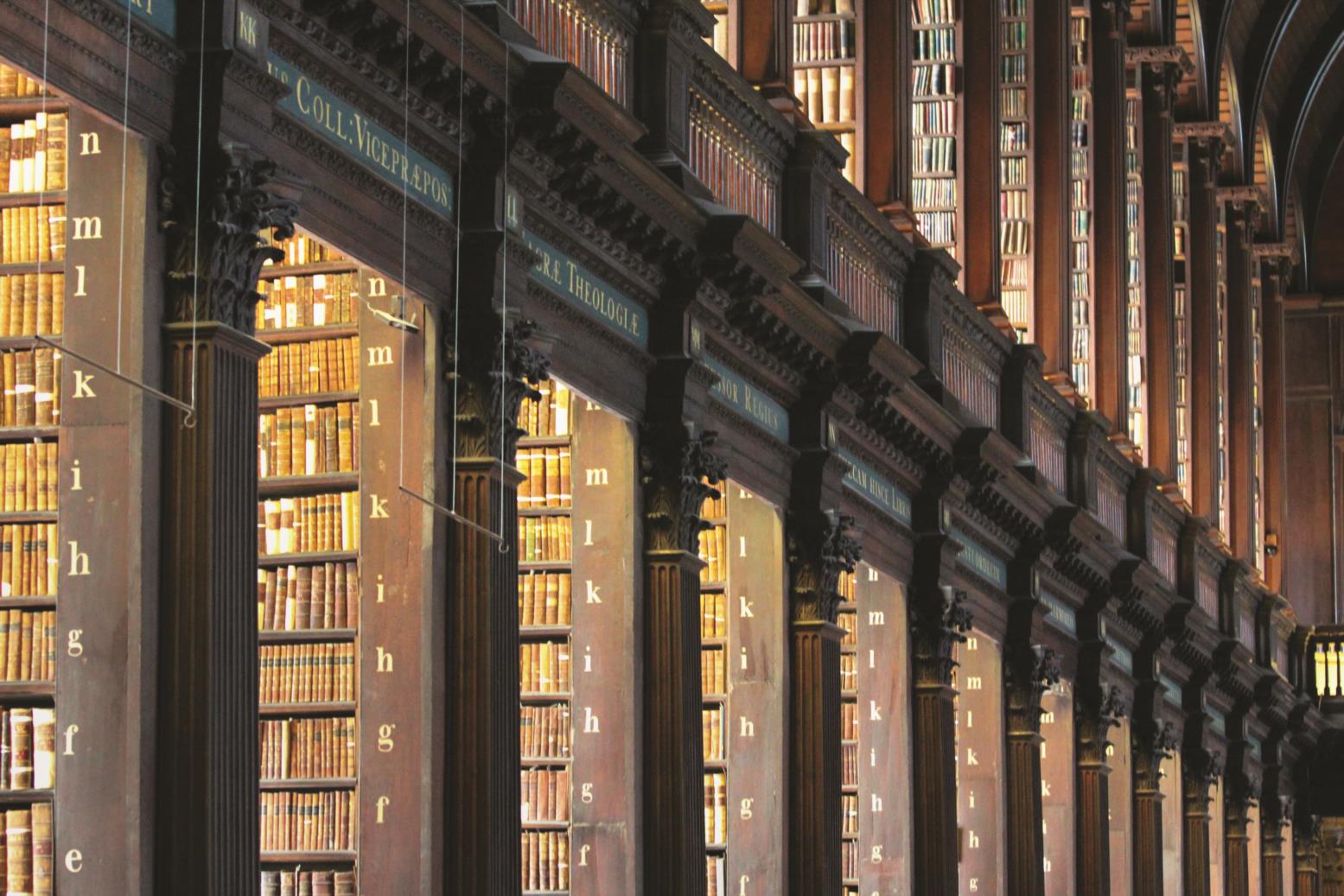
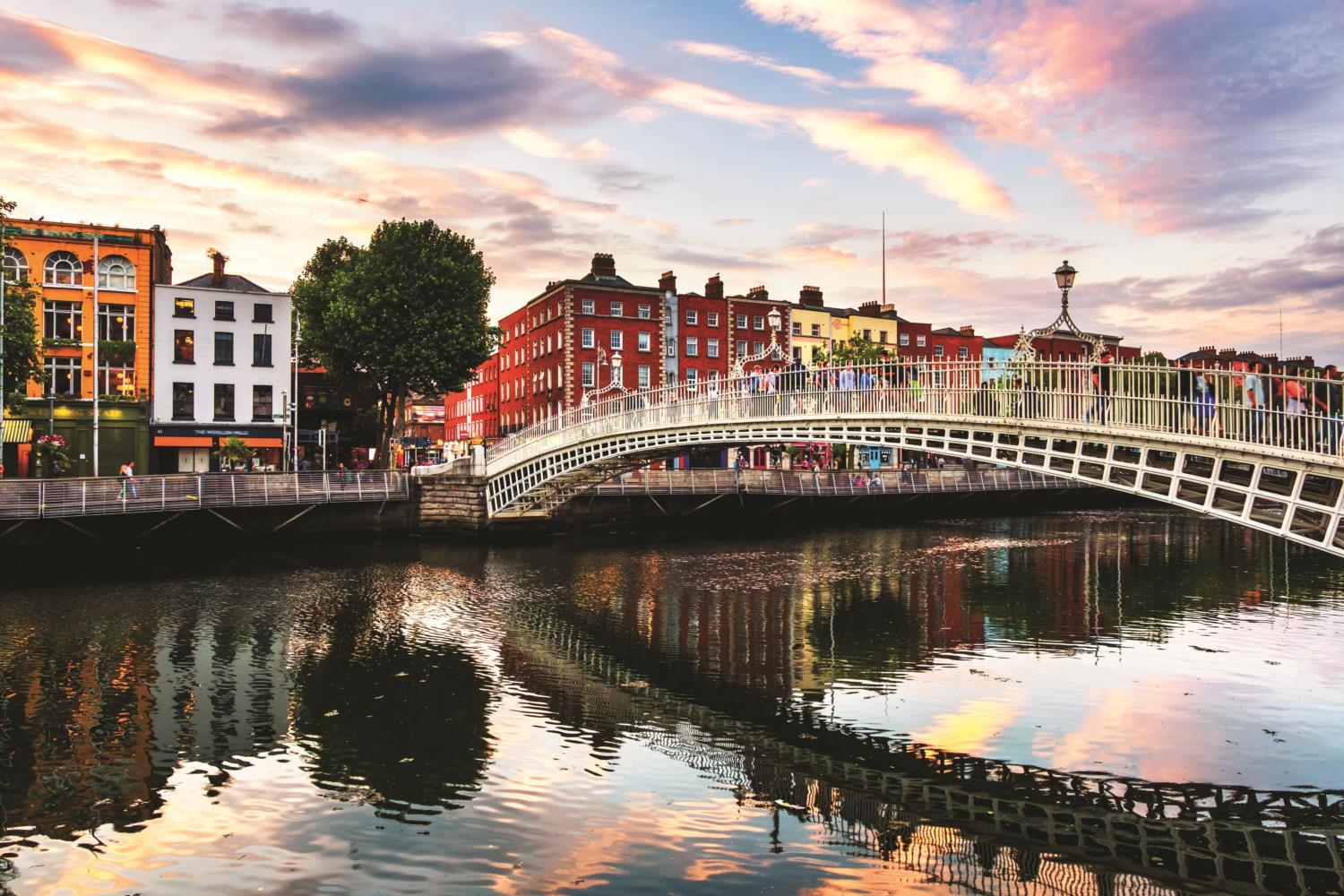 Grandeur, opulence, and sophistication are just a few descriptors that come to mind as I enter the hotel lobby that shimmers with Waterford Crystal chandeliers hanging from the 15-foot ceilings while 18th-century artwork hangs on the walls. The original Georgian architectural detailing remains intact throughout the common areas and I am transported to another time.
The managers offer a warm greeting to the writers’ group I am traveling with. The lilt of their brogue is welcoming, and they invite us to tea in one of the regal dining rooms at the hotel. During tea I learn that the hotel’s director of sales and marketing, Yvonne Donohue, is from Glenamaddy, the small town in County Galway where my grandmother, Catherine Canney, grew up in a modest white thatched-roof cottage with just three rooms and no electricity or running water. Peat was cut from the surrounding bogs to keep the fires stoked for cooking and heat.
The Shelbourne is a world away from how my grandmother lived, and I can’t help but pause and think how thrilled she would be to see her granddaughter in the Lord Mayor’s Lounge having a lavish champagne tea complete with finger sandwiches, scones with clotted cream, and a selection of petit fours—and free-flowing Laurent Perrier La Cuvee. The room, which is painted a cheery butter yellow, is flooded with natural light. We sit at the window overlooking St. Stephen’s Green and watch Dubliners pass by as we indulge and sip, surrounded by the beauty of this space.
Grandeur, opulence, and sophistication are just a few descriptors that come to mind as I enter the hotel lobby that shimmers with Waterford Crystal chandeliers hanging from the 15-foot ceilings while 18th-century artwork hangs on the walls. The original Georgian architectural detailing remains intact throughout the common areas and I am transported to another time.
The managers offer a warm greeting to the writers’ group I am traveling with. The lilt of their brogue is welcoming, and they invite us to tea in one of the regal dining rooms at the hotel. During tea I learn that the hotel’s director of sales and marketing, Yvonne Donohue, is from Glenamaddy, the small town in County Galway where my grandmother, Catherine Canney, grew up in a modest white thatched-roof cottage with just three rooms and no electricity or running water. Peat was cut from the surrounding bogs to keep the fires stoked for cooking and heat.
The Shelbourne is a world away from how my grandmother lived, and I can’t help but pause and think how thrilled she would be to see her granddaughter in the Lord Mayor’s Lounge having a lavish champagne tea complete with finger sandwiches, scones with clotted cream, and a selection of petit fours—and free-flowing Laurent Perrier La Cuvee. The room, which is painted a cheery butter yellow, is flooded with natural light. We sit at the window overlooking St. Stephen’s Green and watch Dubliners pass by as we indulge and sip, surrounded by the beauty of this space.
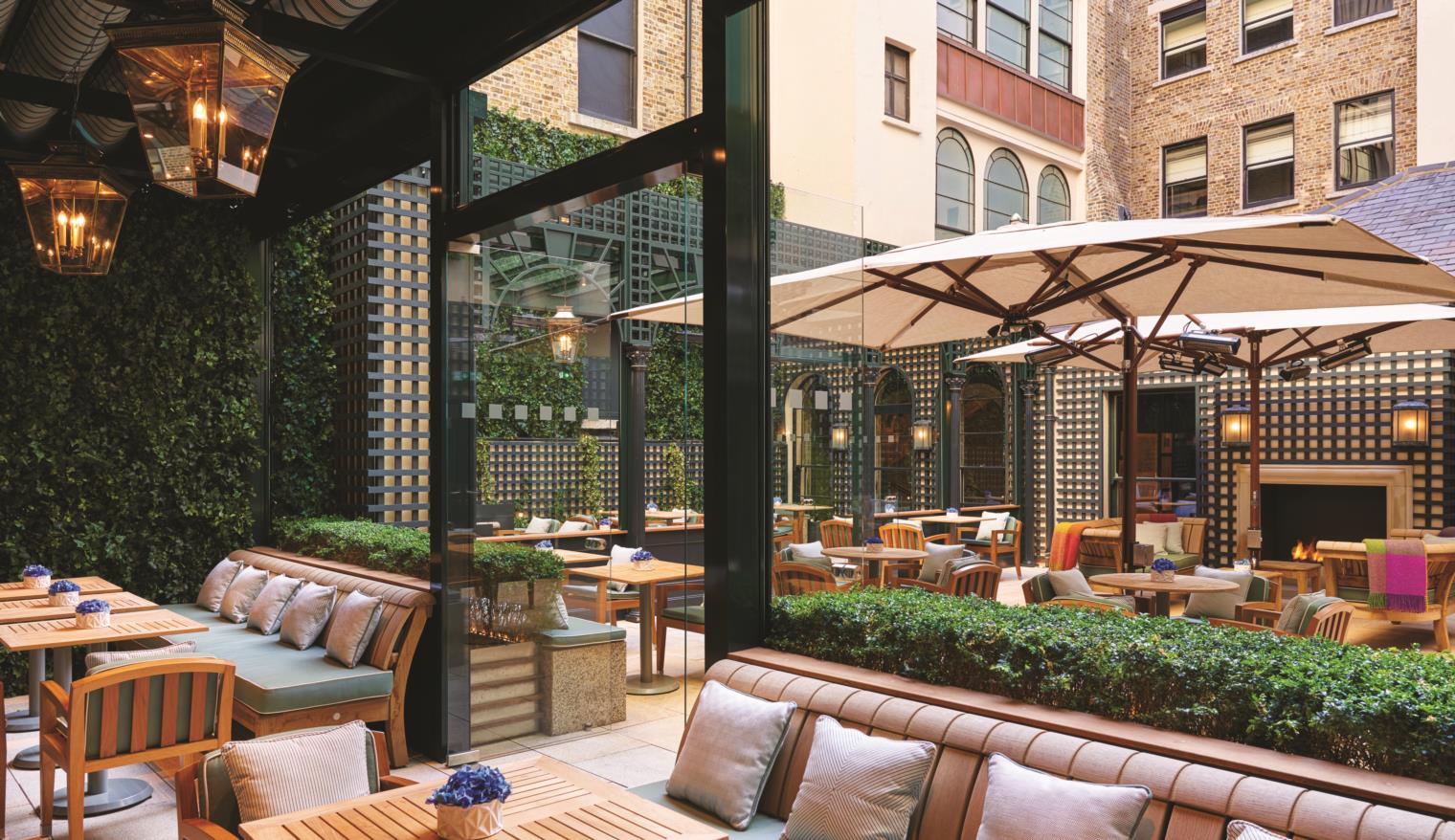
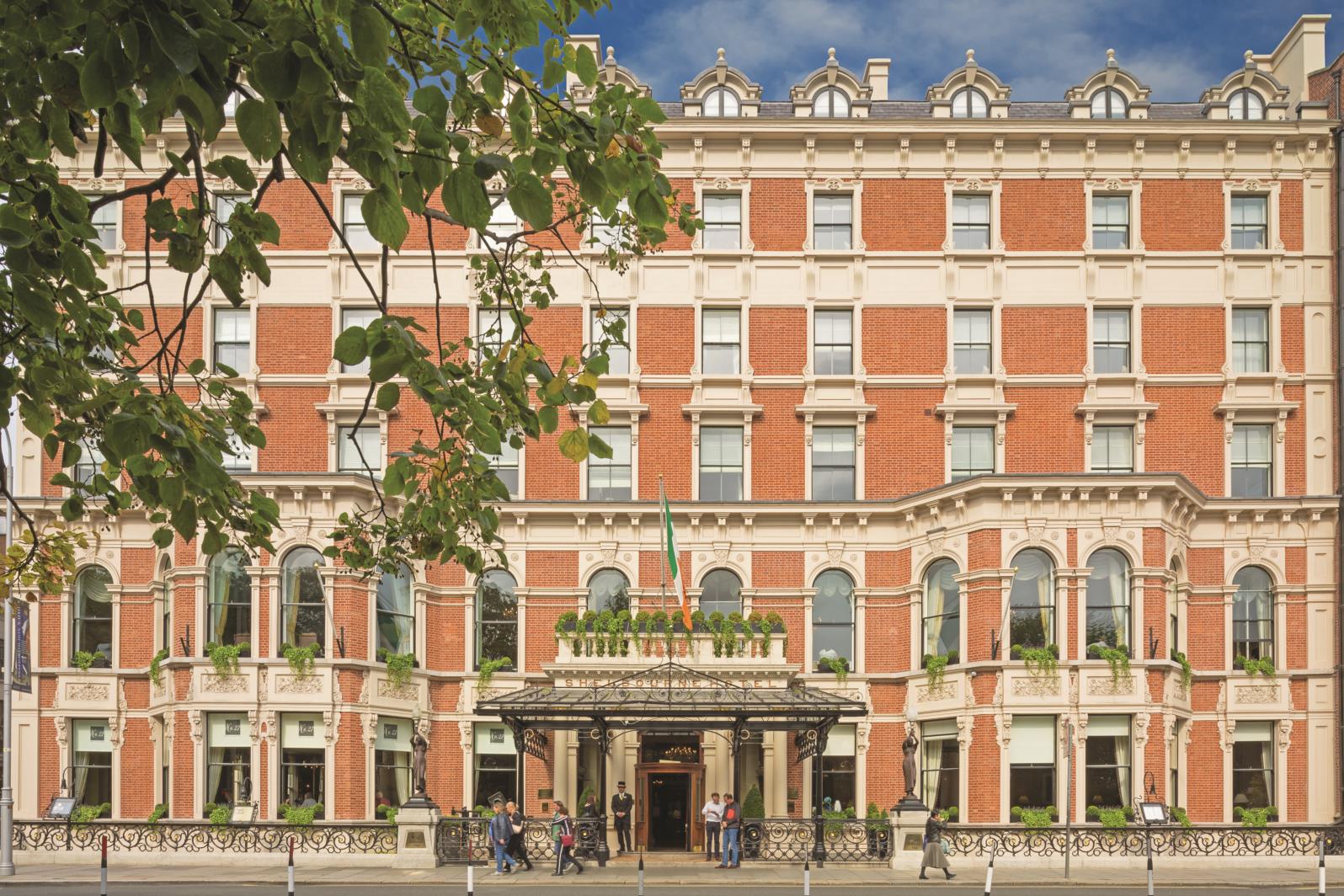 After we are satiated, I check into my hotel room. Handsomely appointed, it offers all the luxury you would expect in a five-star hotel, including soothing blue and beige furnishings, down bedding, and a soaking tub. A writing desk overlooks the green and I again think of my ancestry. My great-uncle Robert Patrick Canney was a writer in both Irish (a Gaelic language) and English, and he traveled the countryside promoting the importance of keeping the ancient language alive. I imagine him sitting here, pen in hand, writing in his native tongue. Today it is still spoken as the first language in areas of the country.
After I drop my bags, I head to the spa for a soothing facial—much needed after my transatlantic journey. Another five-star experience. The treatment rooms are soothing and the relaxation room offers chaise lounges to soak in the tranquil ambiance.
After we are satiated, I check into my hotel room. Handsomely appointed, it offers all the luxury you would expect in a five-star hotel, including soothing blue and beige furnishings, down bedding, and a soaking tub. A writing desk overlooks the green and I again think of my ancestry. My great-uncle Robert Patrick Canney was a writer in both Irish (a Gaelic language) and English, and he traveled the countryside promoting the importance of keeping the ancient language alive. I imagine him sitting here, pen in hand, writing in his native tongue. Today it is still spoken as the first language in areas of the country.
After I drop my bags, I head to the spa for a soothing facial—much needed after my transatlantic journey. Another five-star experience. The treatment rooms are soothing and the relaxation room offers chaise lounges to soak in the tranquil ambiance.
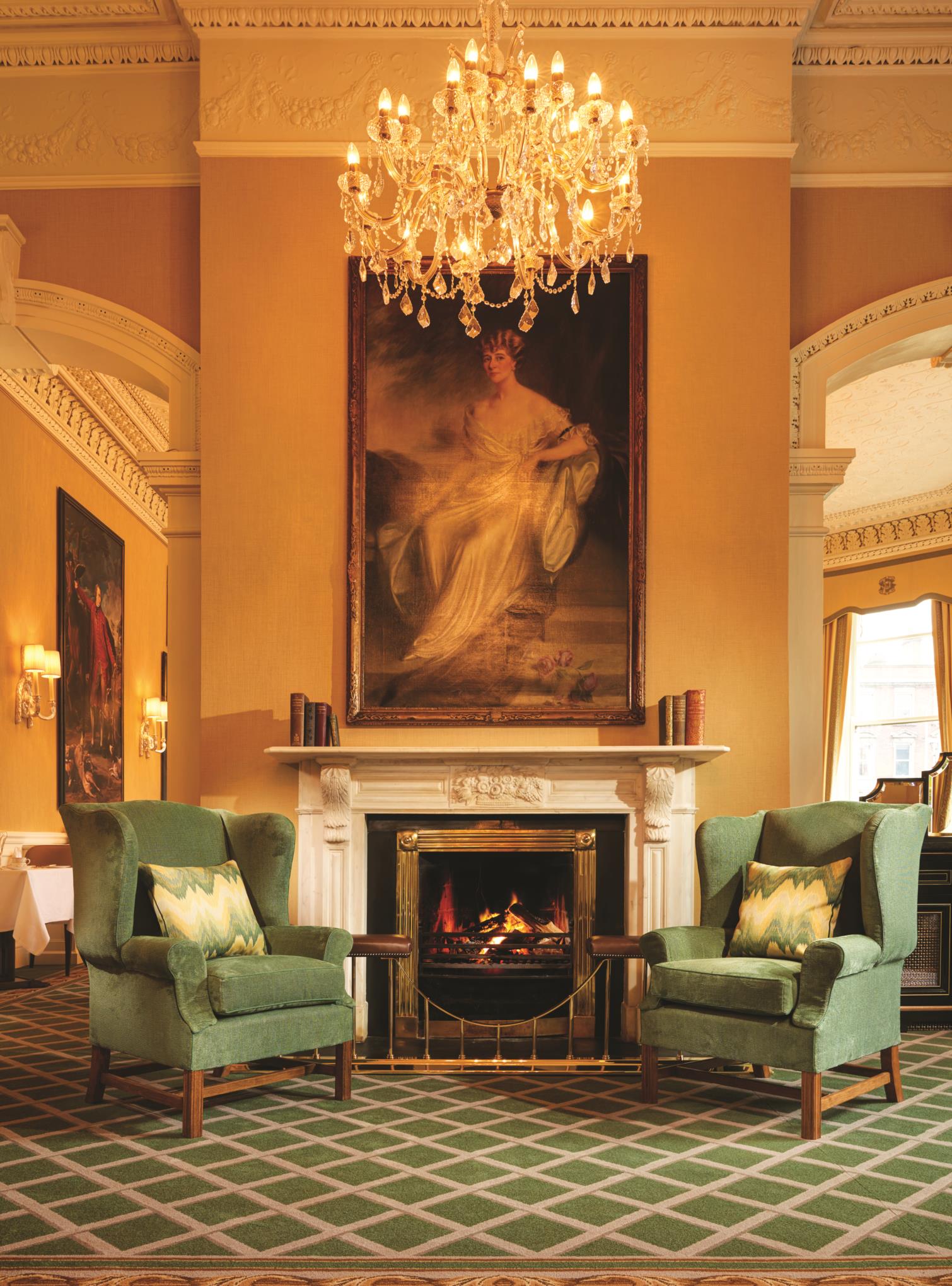
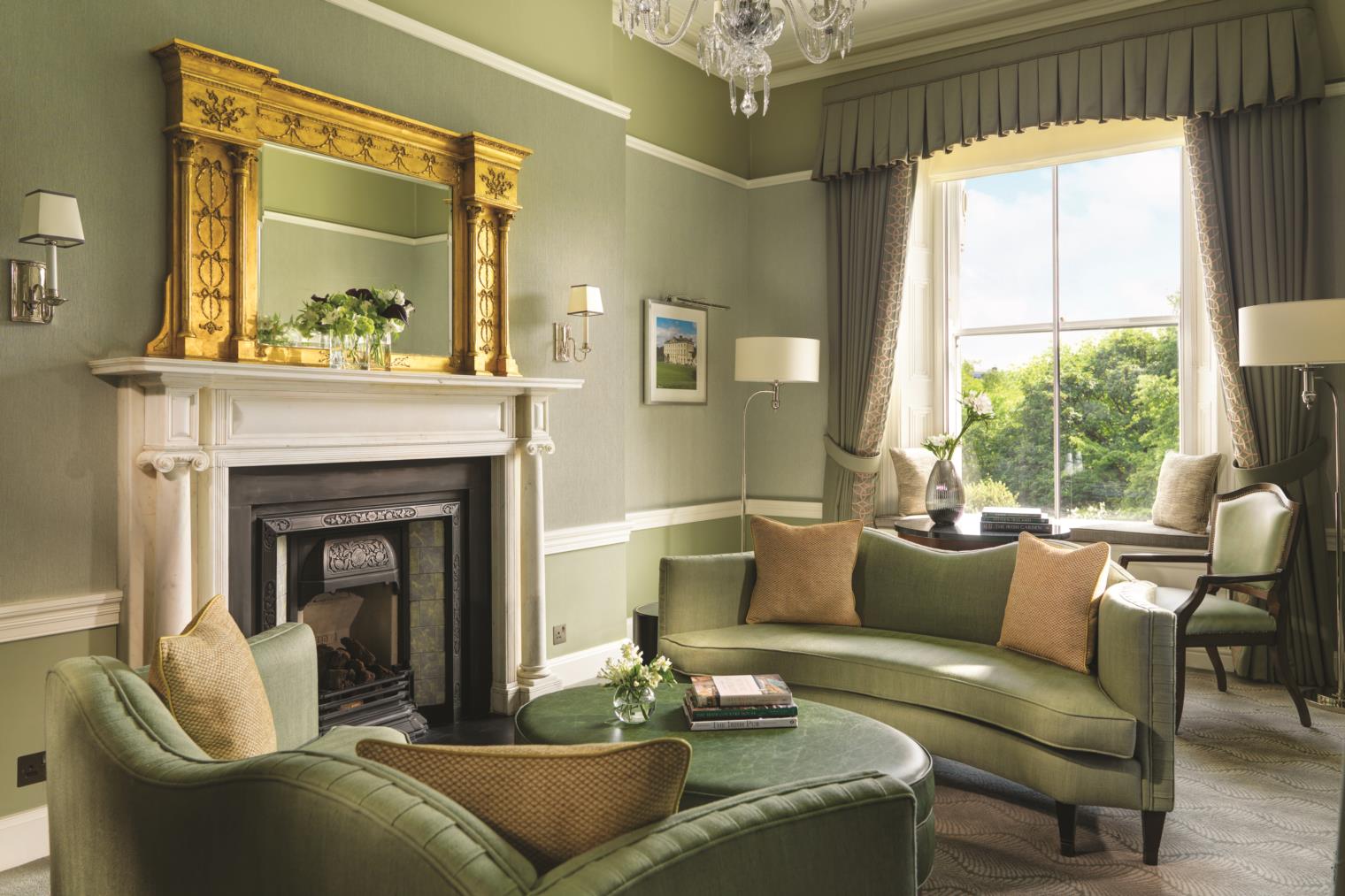 I head back to my room and dress for cocktails and dinner, hosted by Yvonne and general manager JP Kavanagh. Marketing manager Roisin O’Malley also joins the group. A delightful storyteller, she describes life as a young woman in the city of Dublin. She reminds me of the Irish exchange students that stayed with my family when I was a teenager. I can’t resist volunteering when JP asks if anyone would like to uncork a bottle of champagne with a sword. After I give full disclosure that I am left-handed, he hands me the rapier and I strike. The glass bottle lip and cork come off in one swift movement. Pleased with the outcome, I decide I’ve earned my glass of champagne. Dinner is served in the Saddle Room by candlelight, with offerings of seafood and prime cuts of steak. The evening continues with our enchanting hosts, who share the history of the hotel and Dublin’s culture while we dine and indulge in expertly prepared dishes.
The next morning, after a full Irish breakfast, we meander through the cobbled stone passageways of Trinity College to see The Book of Kells, Ireland’s greatest cultural treasure and the world’s most famous medieval manuscript. The ornate ninth-century book was created in a Columban monastery and depicts the four Gospels of the New Testament using calligraphy and illustrations. I’m left in awe of the rich color and intricate designs on the pages, and I am more than happy to spend the rest of the day indulging in my first love—Irish literature and poetry. I head to the Dublin Writers Museum, located in an 18th-century Georgian mansion on the city’s north side. The collection includes works by George Bernard Shaw, Oscar Wilde, James Joyce, and William Butler Yeats, among others. First editions, letters, portraits, and personal items fill the glass cases. Seeing Yeats’s personal artifacts carefully laid out sparks my imagination of him composing the love poem “When You Are Old”—one of my favorites.
I head back to my room and dress for cocktails and dinner, hosted by Yvonne and general manager JP Kavanagh. Marketing manager Roisin O’Malley also joins the group. A delightful storyteller, she describes life as a young woman in the city of Dublin. She reminds me of the Irish exchange students that stayed with my family when I was a teenager. I can’t resist volunteering when JP asks if anyone would like to uncork a bottle of champagne with a sword. After I give full disclosure that I am left-handed, he hands me the rapier and I strike. The glass bottle lip and cork come off in one swift movement. Pleased with the outcome, I decide I’ve earned my glass of champagne. Dinner is served in the Saddle Room by candlelight, with offerings of seafood and prime cuts of steak. The evening continues with our enchanting hosts, who share the history of the hotel and Dublin’s culture while we dine and indulge in expertly prepared dishes.
The next morning, after a full Irish breakfast, we meander through the cobbled stone passageways of Trinity College to see The Book of Kells, Ireland’s greatest cultural treasure and the world’s most famous medieval manuscript. The ornate ninth-century book was created in a Columban monastery and depicts the four Gospels of the New Testament using calligraphy and illustrations. I’m left in awe of the rich color and intricate designs on the pages, and I am more than happy to spend the rest of the day indulging in my first love—Irish literature and poetry. I head to the Dublin Writers Museum, located in an 18th-century Georgian mansion on the city’s north side. The collection includes works by George Bernard Shaw, Oscar Wilde, James Joyce, and William Butler Yeats, among others. First editions, letters, portraits, and personal items fill the glass cases. Seeing Yeats’s personal artifacts carefully laid out sparks my imagination of him composing the love poem “When You Are Old”—one of my favorites.
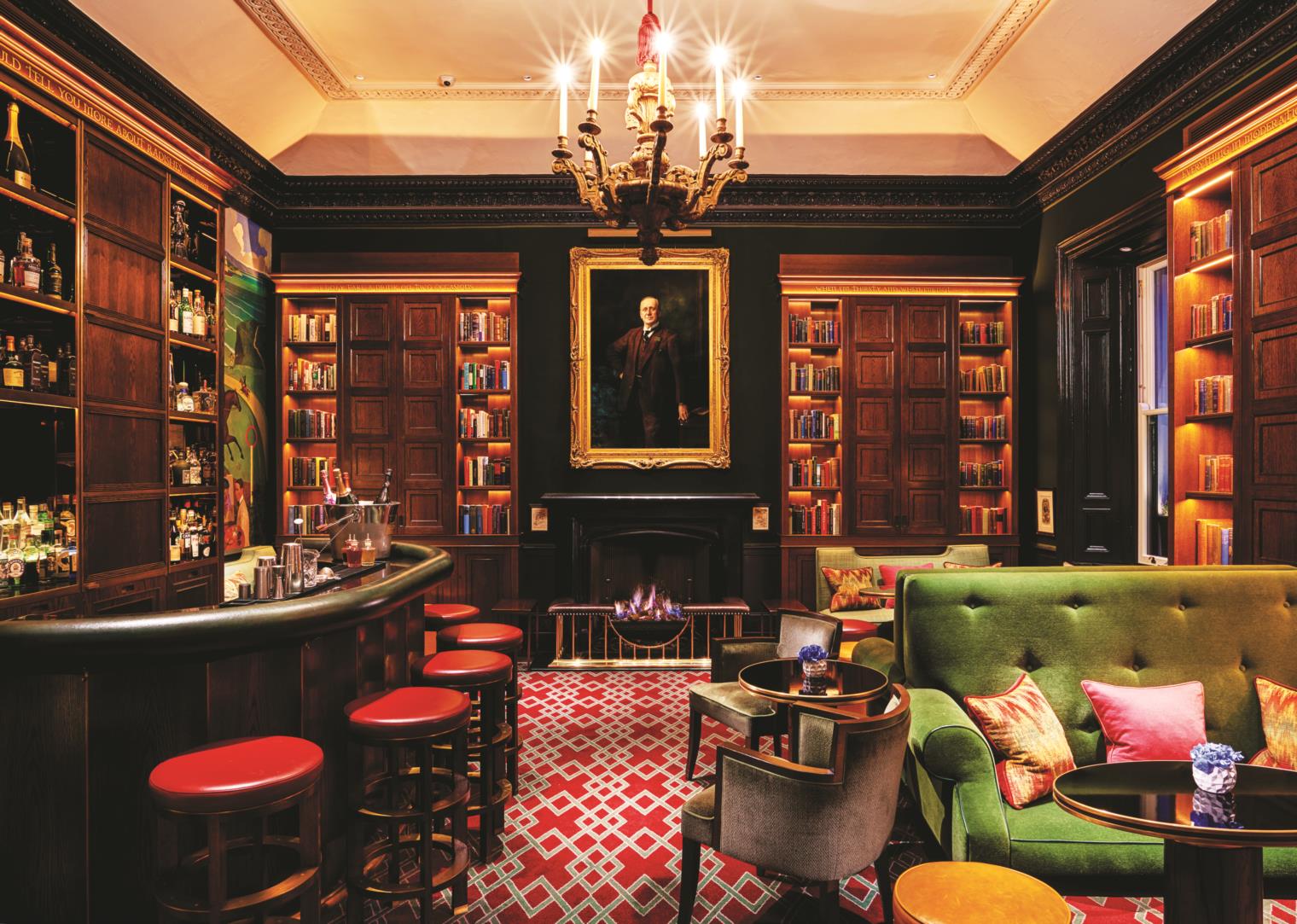
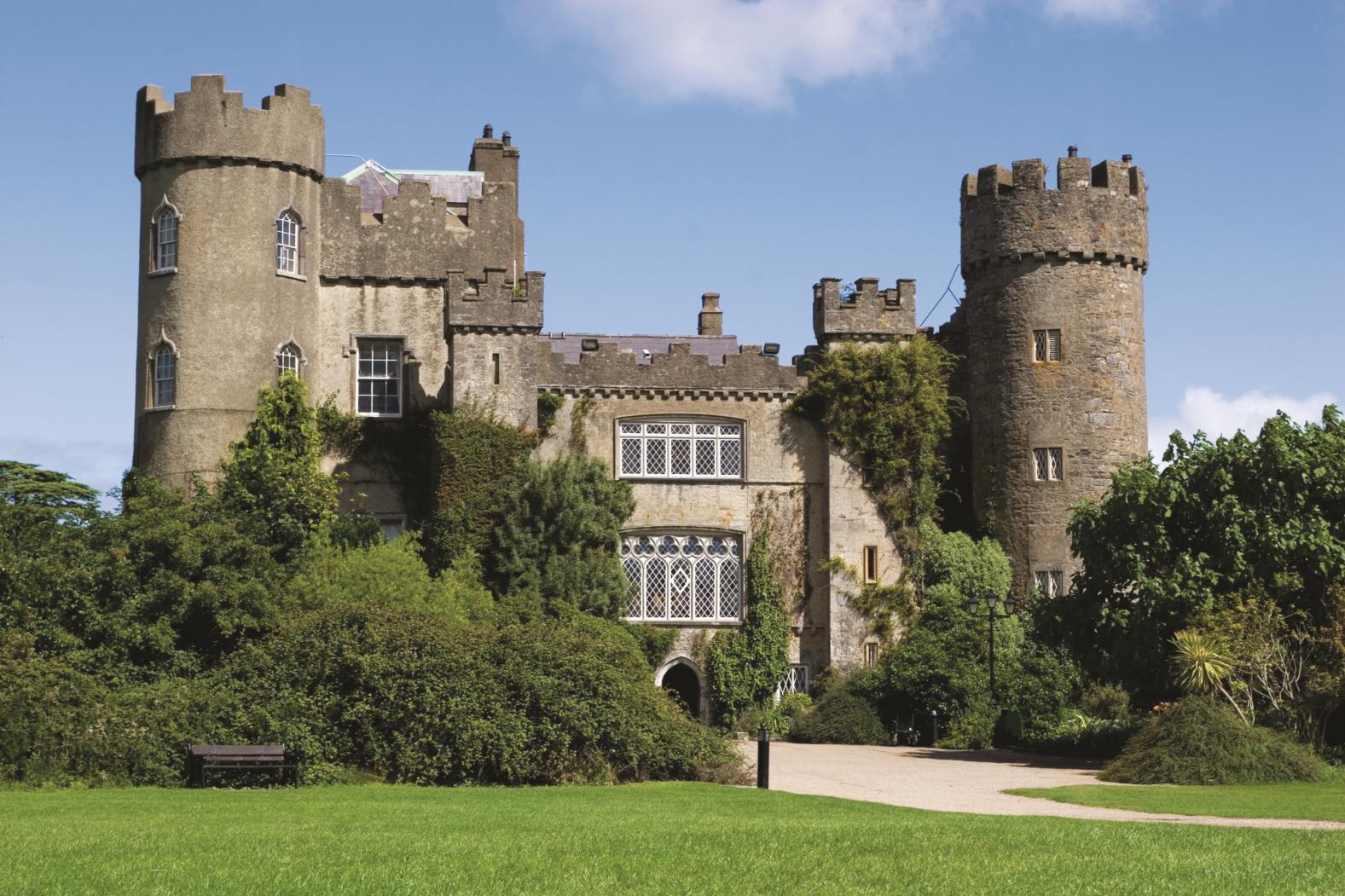 I then join the rest of the group for a sneak peek of the Museum of Literature Ireland (MoLI), a new literary museum embodying a partnership between the University of Dublin and the National Library of Ireland. Opening this summer, it plans to offer interactive experiences as well as performances, lectures, research facilities, and more. After soaking in Ireland’s literary culture, I can’t wait to share all I have discovered with my bibliophile friends back home.
That night, we dine at Delahunt—a hip, relaxed eatery in an old apothecary. Home curing and smoking as well as slow-cooked braises are specialties at this Michelin Bib Gourmand–awarded restaurant. Their house-made Guinness bread is a must, as are the traditional potato soup and main dishes such as roast loin of lamb with sheep’s milk yogurt, plus dishes a bit further afield such as hake with squid ink rice pak choi, crab tempura, and shellfish foam. We grab a nightcap at the Vintage Cocktail Club—with a drinks selection that reaches back to the 1400s and a living room vibe, this is a fun place to experience cocktails through the ages. I settle on a “Banshee,” a concoction made of Irish whiskey, Celtic Honey liqueur, apricot, apple, rhubarb Angostura, and Swedish bitters poured over a block of ice with a sprig of mint. Or, quite simply, heaven in a glass. The next morning, I am up early to visit Malahide Castle and Gardens, located about 30 minutes north of the city center. The castle dates back to 1175, making it one of the oldest castles in Ireland, and was home to the same family—the Talbots—for 800 years. The English family has an impressive legacy in Malahide, as family members were statesmen, churchmen, and scholars throughout the centuries. A tour gives a fascinating glimpse into what life was like in an affluent, powerful British family. In 1975 the family sold the estate to the Irish State, and it is now open for tours.
I then join the rest of the group for a sneak peek of the Museum of Literature Ireland (MoLI), a new literary museum embodying a partnership between the University of Dublin and the National Library of Ireland. Opening this summer, it plans to offer interactive experiences as well as performances, lectures, research facilities, and more. After soaking in Ireland’s literary culture, I can’t wait to share all I have discovered with my bibliophile friends back home.
That night, we dine at Delahunt—a hip, relaxed eatery in an old apothecary. Home curing and smoking as well as slow-cooked braises are specialties at this Michelin Bib Gourmand–awarded restaurant. Their house-made Guinness bread is a must, as are the traditional potato soup and main dishes such as roast loin of lamb with sheep’s milk yogurt, plus dishes a bit further afield such as hake with squid ink rice pak choi, crab tempura, and shellfish foam. We grab a nightcap at the Vintage Cocktail Club—with a drinks selection that reaches back to the 1400s and a living room vibe, this is a fun place to experience cocktails through the ages. I settle on a “Banshee,” a concoction made of Irish whiskey, Celtic Honey liqueur, apricot, apple, rhubarb Angostura, and Swedish bitters poured over a block of ice with a sprig of mint. Or, quite simply, heaven in a glass. The next morning, I am up early to visit Malahide Castle and Gardens, located about 30 minutes north of the city center. The castle dates back to 1175, making it one of the oldest castles in Ireland, and was home to the same family—the Talbots—for 800 years. The English family has an impressive legacy in Malahide, as family members were statesmen, churchmen, and scholars throughout the centuries. A tour gives a fascinating glimpse into what life was like in an affluent, powerful British family. In 1975 the family sold the estate to the Irish State, and it is now open for tours.
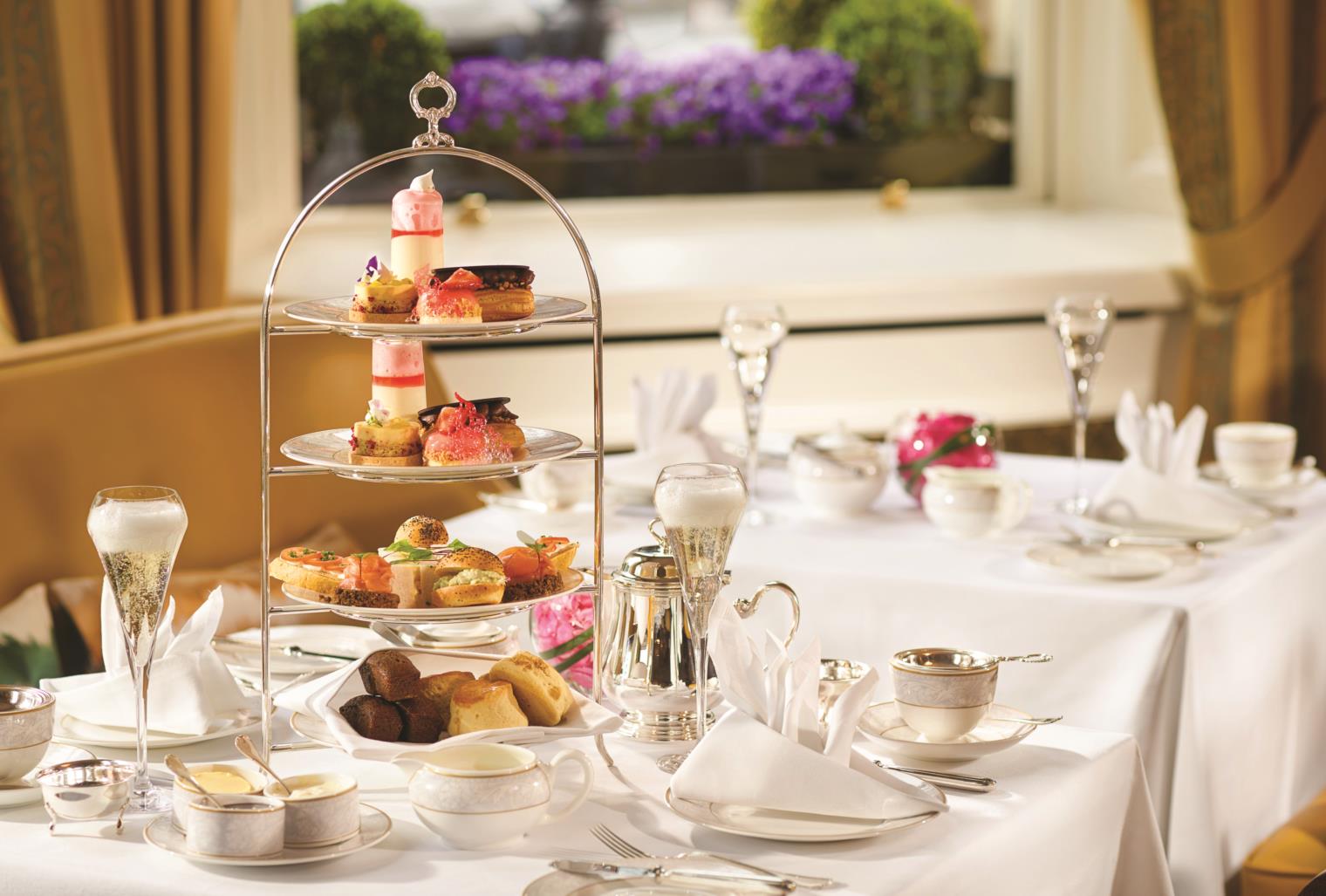 After a day of sightseeing, I go back to the Shelbourne to meet the writers’ group at the hotel’s 1824 Bar. The space, decorated by internationally renowned designer Guy Oliver, features stately oak paneling, bookshelves brimming with Irish authors, comfy green velvet sofas, a mix of antique and contemporary artwork, and a 19th-century Kilkenny limestone fireplace. A mural depicts a fanciful Irish landscape with famous figures who have stayed at the hotel, including Hollywood’s Golden Age film stars Elizabeth Taylor, John Wayne, and Maureen O’Hara. The cocktails are divine and the conversation engaging and lively.
After cocktails, we venture out to The GreenHouse restaurant. Forget everything you have ever heard about Irish cuisine—this is a gastronomic treat typically reserved for the world’s elite. If you are a foodie, you will not want to miss this dining experience. At this Michelin-starred restaurant, chef Mickael Viljanen serves inventive contemporary cuisine using regional produce. This night we dine on seared scallops with black truffle and seared foie gras with pickled and brurnt apple. Hereford beef with black garlic is grilled to perfection. The presentation is as divine as the flavors of the dishes.
A nightcap is called for, as our group is disbanding the next morning. We head to the Shelbourne’s Horseshoe Bar, with its leather banquettes and walls painted a deep red. I opt for my father’s favorite Irish whiskey, a 12-year-old Bushmills, and we toast our Irish hosts for welcoming us to this luxurious institution in the city of Dublin. I’ve decided that the Shelbourne will be my home away from home when I visit the motherland again someday.
The Shelbourne Dublin, A Renaissance Hotel
+ This five-star luxury hotel is the perfect place to make your home base while you are visiting this world-class city.
marriott.com/hotels/travel/dubbr-the-shelbourne-dublin-a-renaissance-hotel
The Saddle Room
+ Located in the Shelbourne Dublin, the restaurant has been reinvented as a steak house and uses ingredients from local farms.
shelbournedining.ie/the-saddle-room-restaurant-dublin
The GreenHouse
+ A Michelin star–rated dining experience not to be missed if you are a true foodie.
thegreenhouserestaurant.ie
Vintage Cocktail Club
+ With the atmosphere of a 1930s speakeasy, this low-lit lounge is the place to go for creative cocktails.
vintagecocktailclub.com
1824 Bar
+ With the feeling of sitting in a cozy manor house library, this Shelbourne bar takes sophistication and tipples to new heights.
shelbournedining.ie/1824-bar-dublin
Grafton Street
+ A traditional High Street just steps away from the Shelbourne offering upscale shopping.
National Gallery
+ Collections and works by the most important artists through the centuries.
nationalgallery.ie
Trinity College Dublin/Book of Kells
+ A ninth-century illuminated manuscript of the four Gospels.
Tcd.ie/visitors/book-of-kells
Malahide Castle and Gardens
+ Malahide Castle dates back to the 12th century and offers a glimpse into the life of the Talbot Family, who lived in the castle for more than 800 years.
malahidecastleandgardens.ie
Museum of Literature
The museum celebrates Ireland’s internationally renowned literary culture and heritage from the past to the present. Open summer 2019.
moli.ie
Aer Lingus operates three weekly flights from Boston to Dublin on Tuesday, Thursday and Saturday. One-way fares start from less than $200 including taxes and charges. For more information on fares and schedules and to book log on to www.aerlingus.com
After a day of sightseeing, I go back to the Shelbourne to meet the writers’ group at the hotel’s 1824 Bar. The space, decorated by internationally renowned designer Guy Oliver, features stately oak paneling, bookshelves brimming with Irish authors, comfy green velvet sofas, a mix of antique and contemporary artwork, and a 19th-century Kilkenny limestone fireplace. A mural depicts a fanciful Irish landscape with famous figures who have stayed at the hotel, including Hollywood’s Golden Age film stars Elizabeth Taylor, John Wayne, and Maureen O’Hara. The cocktails are divine and the conversation engaging and lively.
After cocktails, we venture out to The GreenHouse restaurant. Forget everything you have ever heard about Irish cuisine—this is a gastronomic treat typically reserved for the world’s elite. If you are a foodie, you will not want to miss this dining experience. At this Michelin-starred restaurant, chef Mickael Viljanen serves inventive contemporary cuisine using regional produce. This night we dine on seared scallops with black truffle and seared foie gras with pickled and brurnt apple. Hereford beef with black garlic is grilled to perfection. The presentation is as divine as the flavors of the dishes.
A nightcap is called for, as our group is disbanding the next morning. We head to the Shelbourne’s Horseshoe Bar, with its leather banquettes and walls painted a deep red. I opt for my father’s favorite Irish whiskey, a 12-year-old Bushmills, and we toast our Irish hosts for welcoming us to this luxurious institution in the city of Dublin. I’ve decided that the Shelbourne will be my home away from home when I visit the motherland again someday.
The Shelbourne Dublin, A Renaissance Hotel
+ This five-star luxury hotel is the perfect place to make your home base while you are visiting this world-class city.
marriott.com/hotels/travel/dubbr-the-shelbourne-dublin-a-renaissance-hotel
The Saddle Room
+ Located in the Shelbourne Dublin, the restaurant has been reinvented as a steak house and uses ingredients from local farms.
shelbournedining.ie/the-saddle-room-restaurant-dublin
The GreenHouse
+ A Michelin star–rated dining experience not to be missed if you are a true foodie.
thegreenhouserestaurant.ie
Vintage Cocktail Club
+ With the atmosphere of a 1930s speakeasy, this low-lit lounge is the place to go for creative cocktails.
vintagecocktailclub.com
1824 Bar
+ With the feeling of sitting in a cozy manor house library, this Shelbourne bar takes sophistication and tipples to new heights.
shelbournedining.ie/1824-bar-dublin
Grafton Street
+ A traditional High Street just steps away from the Shelbourne offering upscale shopping.
National Gallery
+ Collections and works by the most important artists through the centuries.
nationalgallery.ie
Trinity College Dublin/Book of Kells
+ A ninth-century illuminated manuscript of the four Gospels.
Tcd.ie/visitors/book-of-kells
Malahide Castle and Gardens
+ Malahide Castle dates back to the 12th century and offers a glimpse into the life of the Talbot Family, who lived in the castle for more than 800 years.
malahidecastleandgardens.ie
Museum of Literature
The museum celebrates Ireland’s internationally renowned literary culture and heritage from the past to the present. Open summer 2019.
moli.ie
Aer Lingus operates three weekly flights from Boston to Dublin on Tuesday, Thursday and Saturday. One-way fares start from less than $200 including taxes and charges. For more information on fares and schedules and to book log on to www.aerlingus.com

